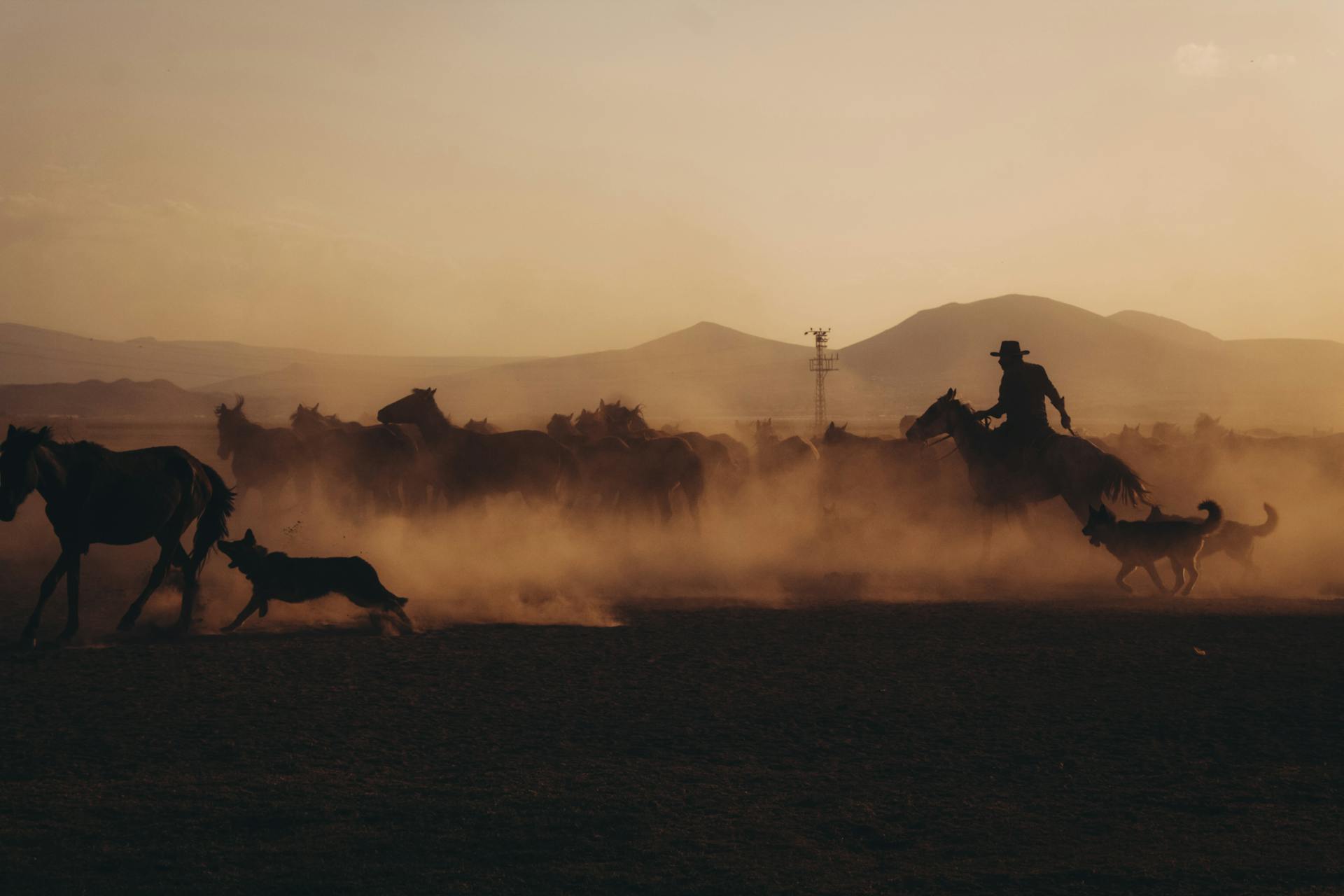
These dogs are a game-changer for farmers and ranchers who want to protect their animals from predators.
Their large size and intimidating presence are enough to deter most predators, including coyotes, wolves, and bears.
With their keen sense of smell and hearing, livestock guardian dogs can detect potential threats from a distance and alert their human caregivers.
They're not just a deterrent, though - they're also fiercely loyal and will defend their animals to the death if necessary.
For another approach, see: Livestock Guardian Animals
Breed Options
If you're looking for a loyal companion to watch over your livestock, consider the Anatolian Shepherd Dog. This breed has been guarding sheep and other animals for thousands of years.
The Anatolian Shepherd Dog is a large dog with a strong temperament that reflects its function as a livestock guardian. It's highly intelligent, courageous, and adaptable, making it a great choice for farmers and ranchers.
The breed standard states that an Anatolian Shepherd Dog should be "loyal, independent, and reserved", which means they can be protective of their territory and may not be friendly to strangers when alone on their property.
Recommended read: Anatolian Shepherd Turkish Kangal
Here are some key characteristics of two popular livestock guardian dog breeds:
Tibetan Mastiffs are known for their ferocity and ability to take on predators like flying predators, coyotes, and bears. They're also hardy and have a thick coat of fur, making them well-suited for cold winters.
Polish Tatra
The Polish Tatra is a gentle giant, standing at a height of 24-28 inches and weighing between 80-130 pounds. They have a lifespan of 10-12 years.
This breed is not as aggressive as some of the other livestock guardian dogs, making them a great option for families with frequent visitors. They're also known for their loud bark, but don't worry, it's not as intimidating as it sounds - they're just trying to protect their flock.
One of the unique features of the Polish Tatra is their alert technique. They move between the flock and predator, alert barking until (if) the predator gets too close. This makes them a great addition to any farm or ranch.
Here are some key characteristics of the Polish Tatra breed:
Overall, the Polish Tatra is a great option for anyone looking for a gentle and effective livestock guardian dog.
Kangal
The Kangal is a great breed option for those looking for a loyal and gentle guardian dog. They have been used as guardian dogs in Turkey since ancient times.
Their speed is impressive, reaching up to 31 miles per hour when needed. This makes them a valuable asset for protecting livestock.
One of the best things about Kangals is their loyalty to their owners. They are also gentle, making them a great choice for families. However, it's worth noting that they can be quite protective of their territory.
Here are some key stats about Kangals:
Overall, the Kangal is a great choice for those looking for a loyal and protective breed that is also gentle and loving.
Caucasian Shepherd
The Caucasian Shepherd is a massive breed, standing between 26-28 inches tall and weighing between 100-220 pounds. They're known for their protective nature and have been used for centuries to guard sheep in the Caucasus mountains.
These dogs are not for the faint of heart - they're fiercely independent and can be stubborn at times. If you're a first-time dog owner, it's best to consider a different breed.
In terms of size, here are the key stats:
They're a hardy breed, but they do require a lot of training and socialization from an early age. If you're up for the challenge, a Caucasian Shepherd can make a loyal and loving companion.
Karakachan
The Karakachan is a dog breed originating from Bulgaria. They're still used as shepherds in their native country and in other nearby countries like Greece, Romania, Serbia, and Macedonia.
Their height is surprisingly consistent, ranging from 24 to 30 inches.
The Karakachan's weight is also relatively stable, between 66 and 120 pounds. This makes them a sturdy breed.
On average, a Karakachan's lifespan is 12 to 14 years. This is a decent lifespan for a dog.
As a guardian dog, the Karakachan can be quite protective of their family. However, this also means they can be aggressive towards strangers if not properly trained.
For your interest: Bulgarian Karakachan Dog
Breed Characteristics
Livestock guardian dogs are typically giant breed dogs with a lot of fur, which helps protect them from the elements and predators as they protect their flocks and herds.
These dogs can grow to be quite large, with some breeds reaching heights of 28-32 inches and weighing between 88-140 pounds.
As independent dogs, they think quickly on their feet and don't need to be told to attack - it's in their DNA to ward off predators with a nasty bark or a charge and attack.
Their independent nature also means they can discern between their family and potential threats, and they're able to do what's necessary to protect their livestock.
Some breeds, like the Anatolian Shepherd, are described as dependable, steady, loyal, brave, and even territorial, making them well-suited for guarding livestock.
The Great Pyrenees
The Great Pyrenees is a beloved livestock guardian breed that originated in Central Asia and was later bred in the Pyrenees mountain range between France and Spain.
They are recognizable due to their large size, striking appearance, and fluffy white coats, which can weigh up to 120 pounds and stand as tall as 32 inches.
Their temperament is defined as "smart, patient, calm" according to the AKC breed standard, making them a gentle giant.
Their independence and ability to think for themselves allows them to guard livestock without human supervision or direction.
The Great Pyrenees has a unique anatomic feature - double dewclaws on the rear legs, which may have functioned as a "snowshoe" in the past.
Here are some key characteristics of the Great Pyrenees breed:
As a livestock guardian breed, the Great Pyrenees is naturally inclined to protect its flock and family, but may need extra training to reinforce its guardian temperament.
Anatolian Shepherd
The Anatolian Shepherd is a breed that's steeped in history, with origins dating back several thousand years to Asia Minor. They were originally used as hunting dogs and later as livestock guardians.
Anatolian Shepherds are large dogs, with a height range of 28-32 inches and a weight range of 88-140 pounds. Their lifespan is typically 10-13 years.
Their intelligence is one of their most notable traits, and they're known for their extremely good sense of hearing. Anatolians are also agile and speedy, making them well-suited for their role as livestock guardians.
As territorial guardians, Anatolians can be wary of strangers when alone on their property. They're described as "loyal, independent, and reserved" by the AKC breed standard.
Here are some key characteristics of the Anatolian Shepherd breed:
Komondor
The Komondor is a unique breed that stands out for its striking appearance and impressive guarding abilities. They can grow to be 25-30 inches tall and weigh 88-110 pounds.
Their distinctive coat is made up of heavy white cords that help them blend in with the sheep they guard. These cords take about 2 years to form and serve as a natural defense against predators and harsh weather conditions.
Komondors are known for their loyal and dignified temperament, making them excellent livestock guardians. They form strong bonds with their flock and are very territorial, which means they tend to stay close to the animals and people they are guarding.
One of the most impressive things about Komondors is their ability to live in cold climates. They can thrive in harsh weather conditions, thanks to their thick coats and robust build.
Here are some key characteristics of the Komondor breed:
It's essential to socialize Komondors at a young age to prevent them from becoming too protective and pinning down visitors. With proper training and socialization, they can make wonderful companions and loyal guardians.
Breed Characteristics
Livestock guardian dogs are typically giant breed dogs with a lot of fur, which helps protect them from both the elements and predators as they protect their flocks and herds.
These dogs can be quite large, with some breeds reaching heights of 28-32 inches and weighing up to 140 pounds.
One of the key characteristics of livestock guardian dogs is their ability to discern between their family and potential threats, allowing them to do what's necessary to protect their livestock.
Livestock guardian breeds are often described as dependable, steady, loyal, brave, and even territorial, which is crucial for their role in protecting their flocks.
Here are some key breed characteristics of popular livestock guardian dog breeds:
These dogs are also known for their intelligence, with some breeds possessing great endurance, speed, and agility, making them highly effective at guarding their flocks.
Similarities Between Guarding
Most livestock guard dog breeds share some key characteristics. They're often over 100 pounds, which can be a significant consideration for owners.
You'll also want to be aware that most LGD breeds are naturally wary of other dogs, including strays, and may not get along with them. This can be a challenge if you have other dogs in the household.
LGD breeds are built to withstand the elements and can live outdoors all year long. Just make sure to provide a good fence, as they may try to expand their territory by breaking through it.
These dogs are known for their independent nature, which can make training and socialization a bit more difficult. They require conscious attention and effort to get them to behave as desired.
Here are some key similarities between LGD breeds:
- Most are over 100 pounds.
- Most are good with familiar people but unfriendly with other dogs.
- They can live outdoors all year long.
- They may try to expand their territory by breaking through insufficient fencing.
- They require conscious attention to both training and socialization.
- They're highly sensitive to livestock behavior.
- Most bark a lot when sensing an unfamiliar or threatening presence.
- Acquiring an LGD will be a financial investment.
Guarding Behavior
Guarding behavior is a crucial aspect of a livestock guardian dog's (LGD) nature. They're designed to protect their charges, and this instinct can be quite intense.
Their entire aim is to ward off any threat to the animals they protect, so they're likely to bark at anything they sense is threatening. This means you can safely assume that if you bring an LGD home, there will be a lot of barking going on at any hour.
Most LGD breeds are over 100 pounds, which can be intimidating to potential threats. This size, combined with their guarding behavior, makes them a formidable protector of your livestock.
As independent thinkers, they require conscious attention to both training and socialization. This means you'll need to put in the effort to teach them what's expected of them and how to interact with people and other animals.
Here are some key characteristics of guarding behavior in LGDs:
- Barking is a primary way they alert you to potential threats.
- They're highly sensitive to livestock behavior and won't harass them when hungry.
- They may try to expand their territory by breaking through insufficient fencing, so a good fence is essential.
History and Features
Livestock guardian dogs originated in Western Asia, on the territory of modern Iran and Iraqi Kurdistan, around 6,000 years ago. This is where domestication of sheep and goats began, and herding became a challenging job for early farmers.
Herders back then didn't have horses, so they managed their livestock on foot, and dogs were tasked with protecting herds from wild predators. These early dogs were strong, vicious, and courageous, and their descendants have retained these traits to this day.
Their use is mentioned in the Old Testament, and images of livestock guardian dogs can be found on ancient works of art.
History
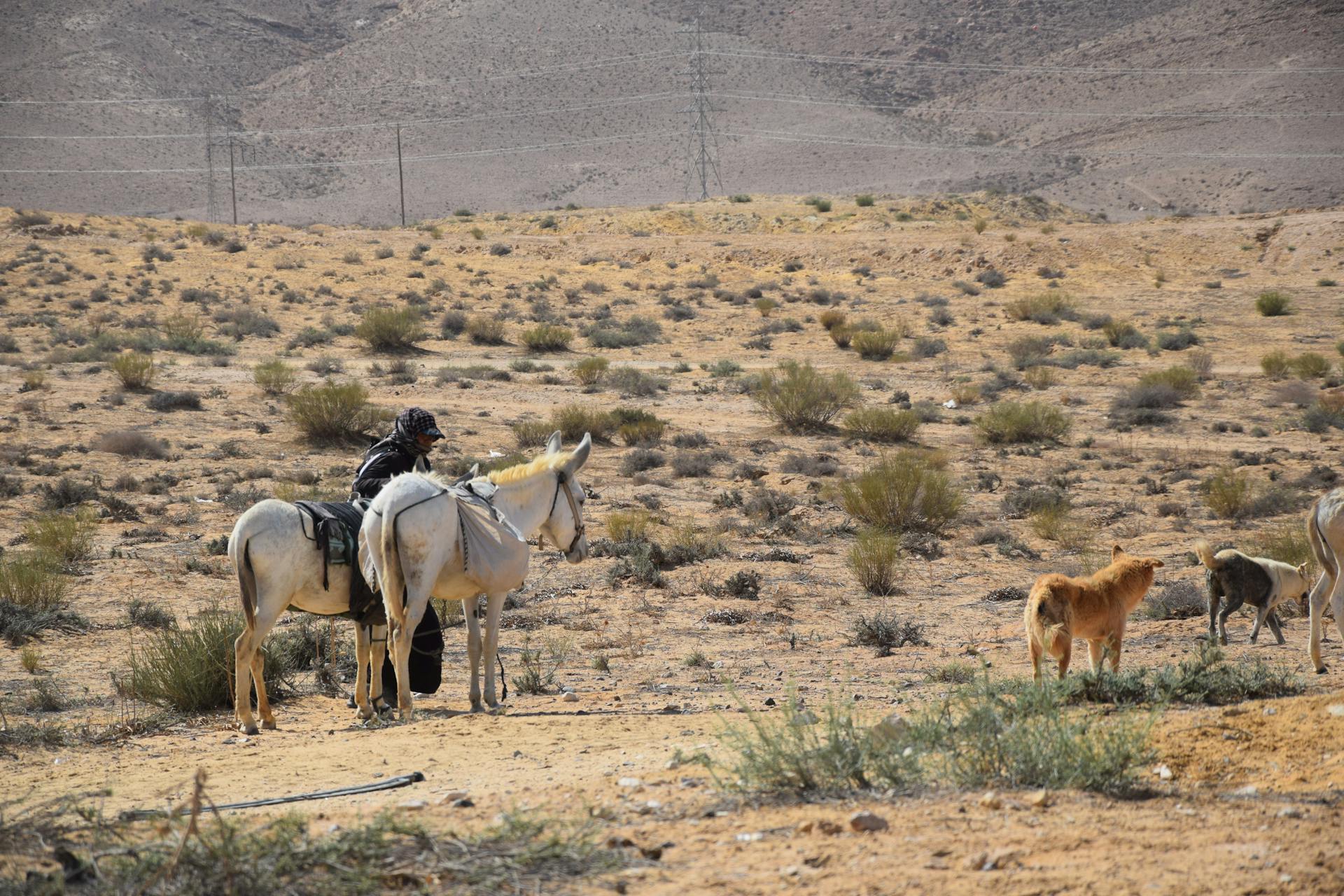
Herding dogs have a rich history that dates back thousands of years. They originated in Western Asia, specifically in the territories of modern Iran and Iraqi Kurdistan.
Domestication of sheep and goats began there around 8-7th millennium BC, and dogs quickly became valuable assistants in farming. They helped protect herds from wild predators, which were abundant at the time.
To do this job effectively, herding dogs had to be strong, vicious, courageous, and decisive. They had to be able to stand up to large predators and defend their herd.
Archaeological findings show that joint remains of sheep and dogs date back to 3685 BC. This is evidence of the early use of livestock guardian dogs.
The land of their origin is considered to be the territories of modern Turkey, Iraqi Kurdistan, and Syria. This area is where the ancestors of livestock guardian dogs can be traced back to six thousand years ago.
Herding dogs are mentioned in the Old Testament, the works of Cato the Elder and Varro, and images of them can be found on ancient works of art created over two thousand years ago.
Worth a look: Bull Terrier 100 Years Ago vs Now
Working Features
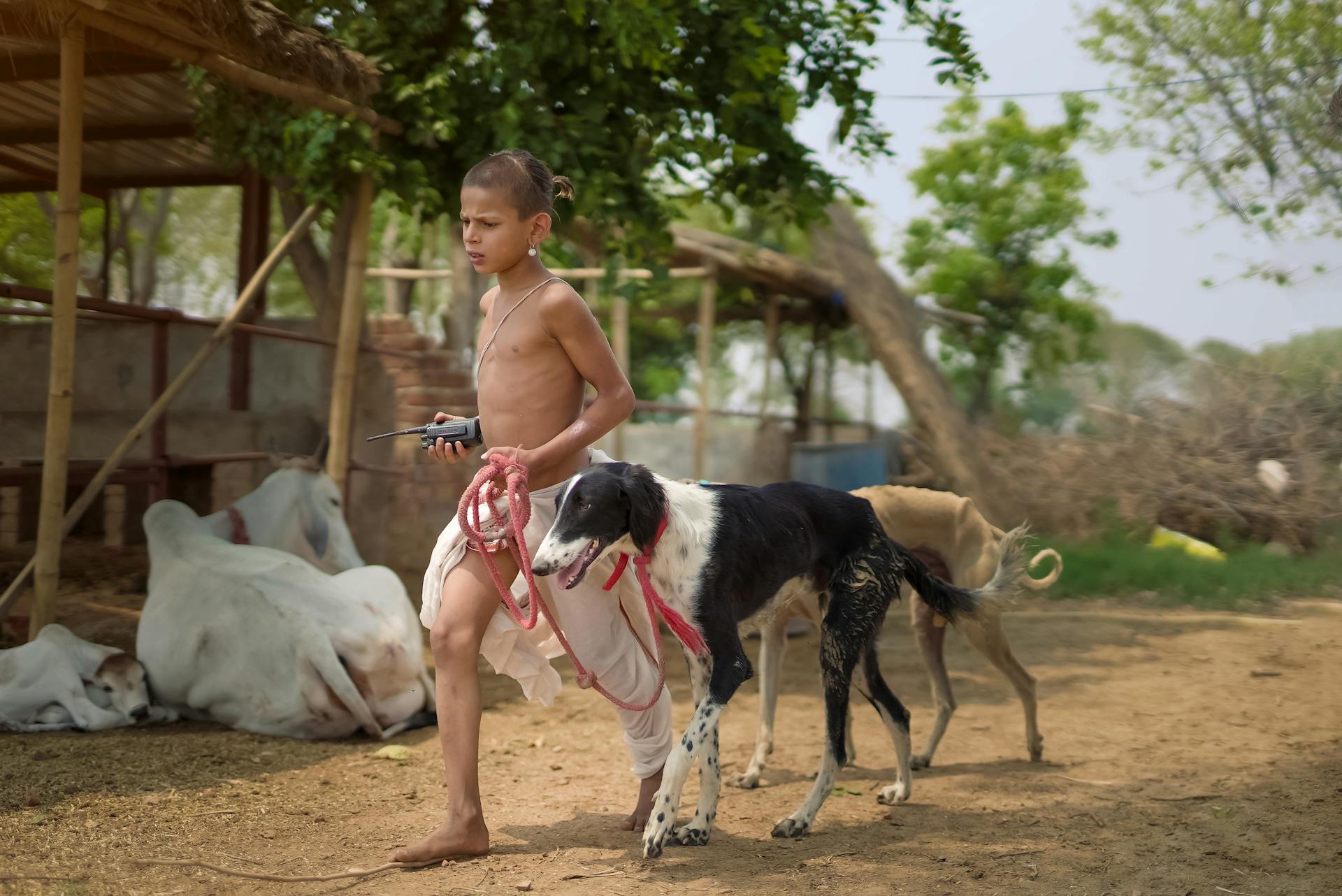
The working features of this system are quite impressive. They allow for seamless integration with various devices, including smartphones and laptops.
With the ability to process complex algorithms in real-time, it can handle multiple tasks simultaneously, making it an efficient tool for users. This is especially useful for professionals who need to manage multiple projects at once.
One of the standout features is its advanced language processing capabilities, which enable it to understand and respond to natural language inputs. This means users can communicate with it in a more conversational way, making it feel more like a personal assistant.
It can also learn and adapt to user behavior, allowing it to provide more personalized recommendations and results over time. This feature is particularly useful for users who want to make the most of the system's capabilities.
You might like: Dog Body Language with Other Dogs
The Modern World
In the modern world, livestock guardian dogs are often used for purposes other than their original intention of protecting herds. They can be gentle and make good companion dogs, but their protective instincts can also make them less than ideal for urban or suburban living.
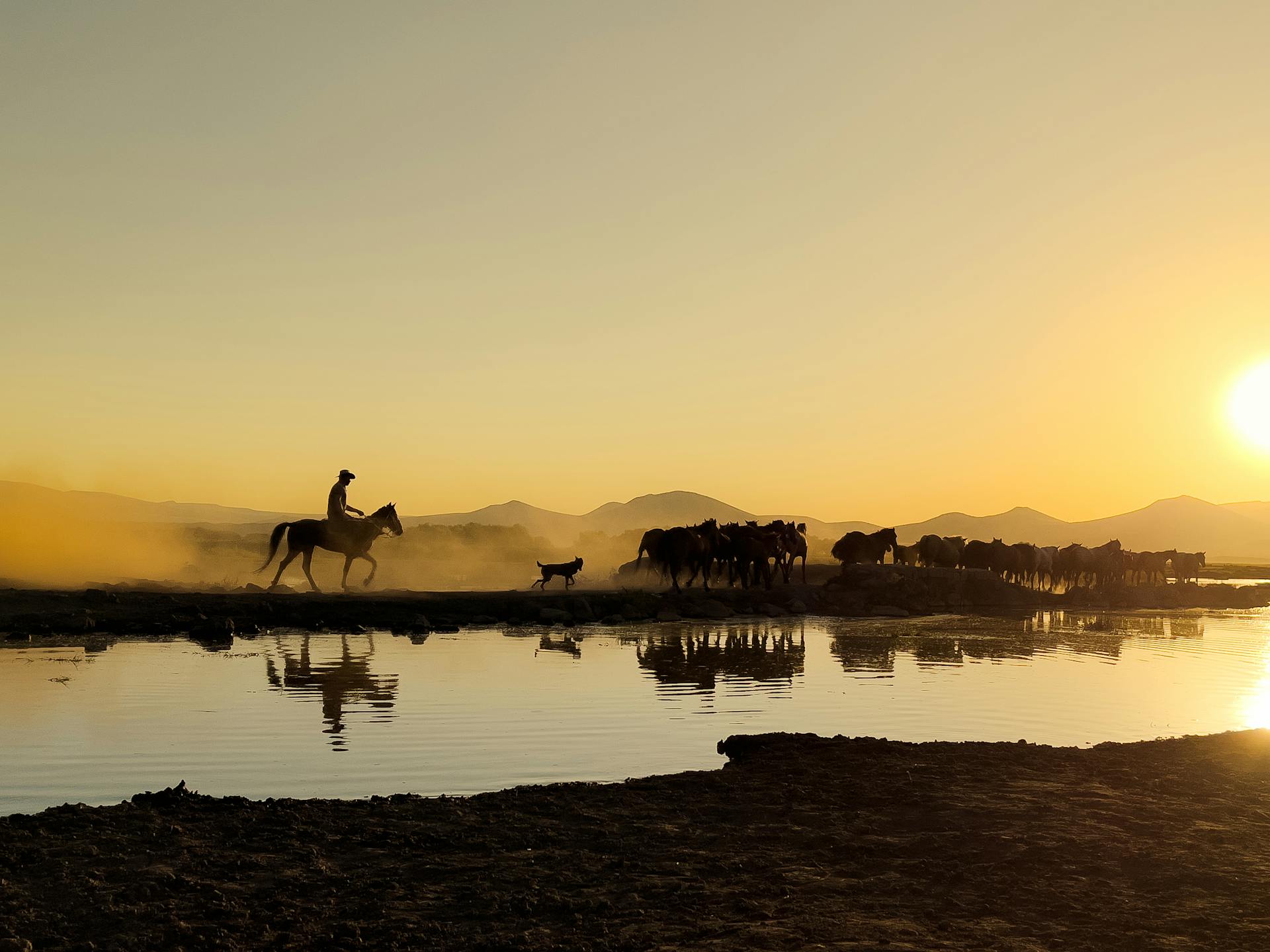
Their size can be deceiving, as most LGDs are as protective of their family as a working guard dog is of its flock. This is especially true if they're introduced to a family as a pup.
Unfortunately, the number of LGDs has critically declined in many regions due to the decline in livestock and transition to other methods of breeding and management. This has led to a loss of hereditary guarding skills and key working qualities.
Some breeds, like the Pyrenean mountain dog, are kept mainly as pets, while others, like the Karakachan dog in Bulgaria, are on the verge of extinction. This is a worrying trend, as LGDs are still the most efficient and sustainable way of protecting herds.
In fact, the use of livestock guardian dogs for herd protection has been shown to reduce losses by 11-100% without requiring significant investments or special technologies.
Extant
The breed diversity of ancient dog breeds is quite astounding. These breeds have been around for thousands of years, with some originating from as far back as ancient civilizations.
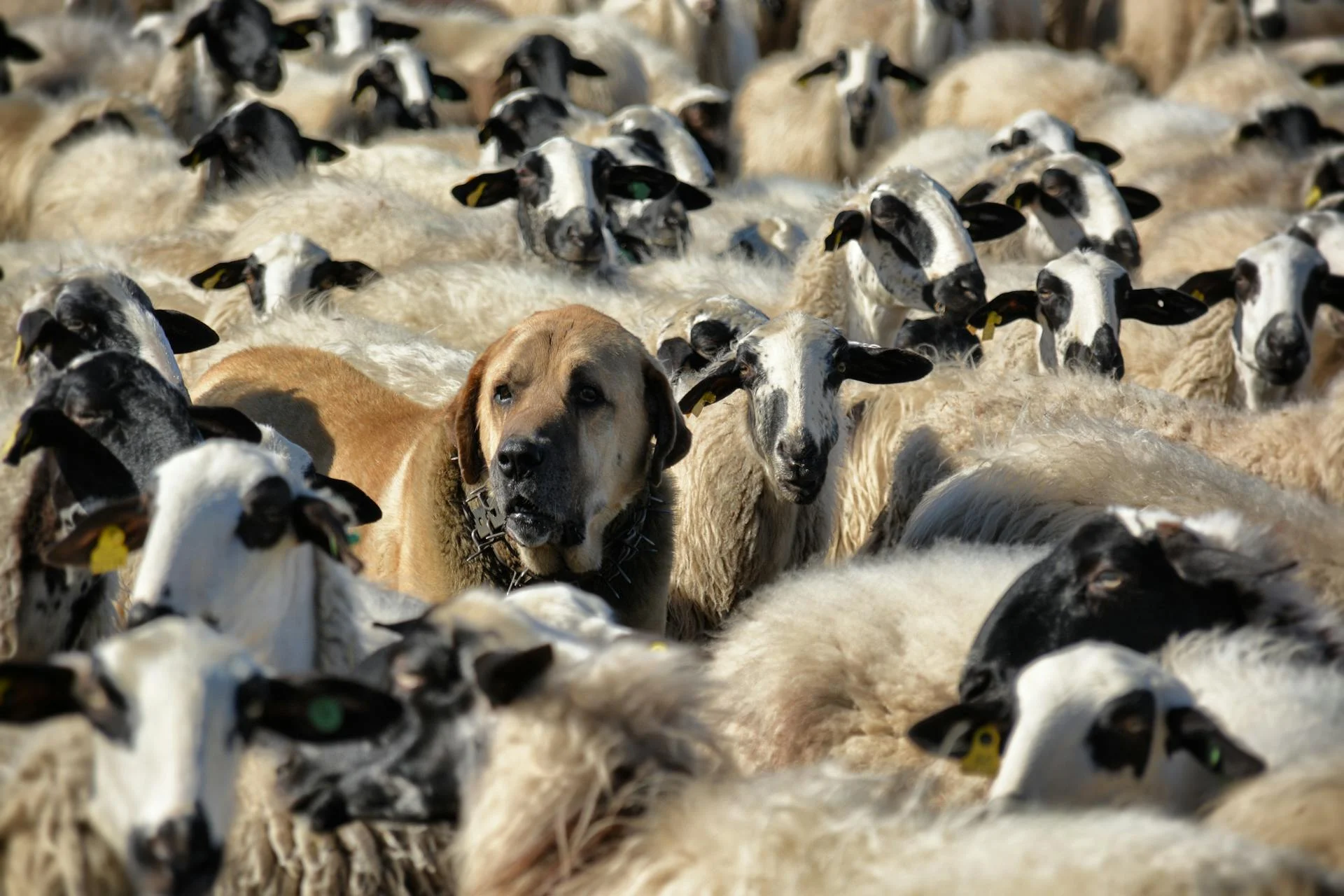
The Aidi, for example, is an old breed from Morocco that has been used as a guard dog for centuries. It's also known as the Atlas Mountain Dog or Berber Dog.
In contrast, the Great Pyrenees is a breed that originated in the Pyrenees Mountains between France and Spain. It's been used to guard sheep and has been around for over 1,000 years.
The Tibetan Mastiff is another ancient breed that originated in Tibet. It's known for its large size and protective instincts.
Here's a list of some of the countries where these ancient breeds originated:
- Morocco: Aidi, Atlas Mountain Dog, Berber Dog
- France and Spain: Great Pyrenees
- Tibet: Tibetan Mastiff
- Iran: Persian Mastiff, Shirak Sheepdog, Mazandrani dog, Ghadrejani dog
- Turkey: Akbash dog, Kangal, Koyun dog, Kars
- Italy: Maremmano-Abruzzese Sheepdog, Cane di Mannara
- Portugal: Cão de Castro Laboreiro, Cão de Gado Transmontano, Rafeiro do Alentejo
- Romania: Bucovina Shepherd, Mioritic Shepherd, Carpathian Shepherd Dog
- Georgia: Caucasian Shepherd Dog
- Azerbaijan: Azerbaijani Shepherd Dog, Gurdbasar
- Afghanistan: Central Asian Shepherd Dog, Kuchi
- Kazakhstan: Tobet
- Uzbekistan: Torkuz
Frequently Asked Questions
Can you keep a livestock guardian dog as a pet?
While it's possible to keep a livestock guardian dog in an urban or suburban setting, a rural or country home is generally the best fit for these dogs. If you're considering bringing an LGD into your life, it's essential to research their specific needs and lifestyle requirements.
What are the problems with livestock guardian dogs?
Common issues with livestock guardian dogs include wandering off and failing to protect livestock, often due to a desire for freedom or lack of respect for boundaries
Are livestock guardian dogs aggressive to people?
Livestock guardian dogs (LGDs) are bred to be defensively aggressive, but their reaction to a threat can vary in speed and intensity. While they may appear aggressive, their primary goal is to protect their flock, not people.
What is the longest living livestock guardian dog?
The Rafeiro do Alentejo breed has a life expectancy of 14 years, making it a relatively long-lived livestock guardian dog.
How long do livestock guardian dogs live?
Livestock guardian dogs typically live for 10-17 years, with many remaining active throughout their lifespan. Proper care can help ensure they live a long and healthy life.
Sources
- https://www.dogster.com/dog-breeds/livestock-guardian-dog-breeds
- https://en.wikipedia.org/wiki/Livestock_guardian_dog
- https://www.thesprucepets.com/livestock-guardian-dog-breeds-7569151
- https://www.akc.org/expert-advice/dog-breeds/get-to-know-the-livestock-guardian-dog-breeds/
- https://niteguard.com/5-livestock-guardian-dog-breeds/
Featured Images: pexels.com


